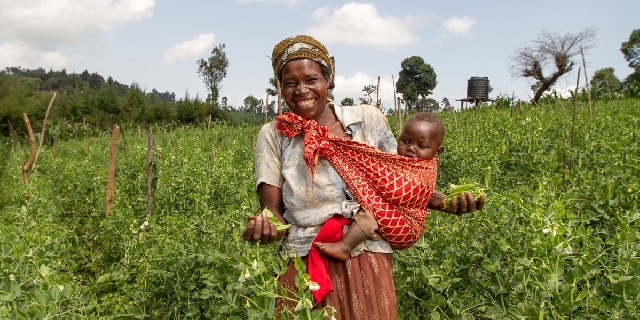World Banks latest food security update
 Food security is a big issue in Africa
Food security is a big issue in Africa
Domestic food price inflation remains high around the world. Information from the latest month between October 2022 and February 2023 for which food price inflation data are available shows high inflation in almost all low- and middle-income countries, with inflation levels above 5% in 88.2% of low-income countries, 93% of lower-middle-income countries, and 89.0% of upper-middle-income countries and many experiencing double-digit inflation. In addition, about 85.7% of high-income countries are experiencing high food price inflation. The countries affected most are in Africa, North America, Latin America, South Asia, Europe, and Central Asia.
Download the latest brief on rising food insecurity and World Bank responses
The agricultural, cereal, and export price indices closed 3%, 2%, and 2% lower, respectively than two weeks ago. The prices of all three cereals fell, with maize and rice prices closing 1% lower and wheat closing 2% lower than two weeks ago. Maize prices are 13% lower and wheat prices almost 34% lower from the highs of more than a year ago, when Russia invaded Ukraine; rice prices are 17% higher. Maize and wheat prices are 22% and 4% higher, respectively, than in January 2021, while rice prices are 4% lower. (See “pink sheet” data for agricultural commodity and food commodity prices indices, updated monthly.)
One year after Russia’s invasion of Ukraine, the International Food Policy Research Institute (IFPRI) reviews the impacts on fertilizer production, prices, and trade flows. Russia’s 2022 invasion disrupted key markets and supply chains for crops and fertilizers that significantly affect global food security. High international food prices have eased, but domestic prices remain high in many low- and middle-income countries. Although still high, fertilizer prices have fallen from their 2022 peaks because of shifting supplies and trade linkages.
According to a recent report from the Food and Agriculture Organization of the United Nations (FAO), the benchmark index of international food commodity prices declined for the 11th consecutive month in February 2023. The FAO Food Price Index averaged 129.8 points in February, a marginal 0.6 percent decrease from January 2023 and an 18.7% decrease from its peak in March 2022.
A March 2023 report from the United Nations Conference on Trade and Development (UNCTAD) stressed that the Black Sea Grain Initiative has helped bring down the cost of food and stabilize global markets and keep them open. As of March 5, 2023, more than 23 million tonnes of grain had been exported through the initiative. Developing countries have benefited the most from the deal, having received 49% of food exports under the initiative. Least developed countries have received just 6% of grain exports under the initiative and developed countries have received 45%. Corn and wheat account for most exports under the initiative, together accounting for 77% of cargo shipped. At the same time, the report highlights that further progress could be made, with food prices remaining higher than before the war.
Following Russia’s invasion of Ukraine, trade-related policies imposed by countries have surged. The global food crisis has been partially made worse by the growing number of food trade restrictions put in place by countries with a goal of increasing domestic supply and reducing prices. As of March 13, 2023, 23 countries have implemented 29 food export bans, and ten have implemented 14 export-limiting measures.
According to the Global Report on Food Crisis 2022 Mid-year Update, up to 205 million people are expected to face acute food insecurity and to be in need of urgent assistance in 45 countries.
World Bank Action
As part of a comprehensive, global response to the food security crisis, in April 2022 the World Bank announced that it is making up to $30 billion available over a period of 15 months, including $12 billion in new projects. The financing is to scale up short- and long-term responses along four themes to boost food and nutrition security, reduce risks, and strengthen food systems: (i) support producers and consumers, (ii) facilitate increased trade in food and trade inputs, (iii) support vulnerable households, and (iv) invest in sustainable food and nutrition security.
The Bank has achieved its target of making $30 billion commitment for food and nutrition security response. Between April to December 2022, the Bank’s food and nutrition security commitments in new lending have passed the $12 billion mark – with almost half for Africa, which is one of the hardest hit regions by the food crisis. Some examples include:
A $150 million grant for the second phase of the Yemen Food Security Response and Resilience Project, which will help address food insecurity, strengthen resilience and protect livelihoods. $50 million grant of additional financing for Tajikistan to mitigate food and nutrition insecurity impacts on households and enhance the overall resilience of the agriculture sector. A $125 million project in Jordan aims to strengthen the development the agriculture sector by enhancing its climate resilience, increasing competitiveness and inclusion, and ensuring medium- to long-term food security. A $300 million project in Bolivia that will contribute to increasing food security, market access and the adoption of climate-smart agricultural practices. A $315 million loan to support Chad, Ghana and Sierra Leone to increase their preparedness against food insecurity and to improve the resilience of their food systems. A $500 million Emergency Food Security and Resilience Support Project to bolster Egypt's efforts to ensure that poor and vulnerable households have uninterrupted access to bread, help strengthen the country's resilience to food crises, and support to reforms that will help improve nutritional outcomes. A $130 million loan for Tunisia, seeking to lessen the impact of the Ukraine war by financing vital soft wheat imports and providing emergency support to cover barley imports for dairy production and seeds for smallholder farmers for the upcoming planting season. The $2.3 billion Food Systems Resilience Program for Eastern and Southern Africa, helps countries in Eastern and Southern Africa increase the resilience of the region’s food systems and ability to tackle growing food insecurity. The program will enhance inter-agency food crisis response also boost medium- and long-term efforts for resilient agricultural production, sustainable development of natural resources, expanded market access, and a greater focus on food systems resilience in policymaking.In May, the World Bank Group and the G7 Presidency co-convened the Global Alliance for Food Security, which aims to catalyze an immediate and concerted response to the unfolding global hunger crisis. The Alliance has developed the publicly accessible Global Food and Nutrition Security Dashboard, which provides timely information for global and local decision-makers to help improve coordination of the policy and financial response to the food crisis.
The heads of the FAO, IMF, World Bank Group, WFP, and WTO released a Third Joint Statement on February 8, 2023. The statement calls to prevent a worsening of the food and nutrition security crisis, further urgent actions are required to (i) rescue hunger hotspots, (ii) facilitate trade, improve the functioning of markets, and enhance the role of the private sector, and (iii) reform and repurpose harmful subsidies with careful targeting and efficiency. Countries should balance short-term urgent interventions with longer-term resilience efforts as they respond to the crisis.
Last Updated: Mar 27, 2023
Source: World Bank
Trending Features

Russia–Africa:New horizons for old friends
09:23
Justice for sale: When poverty becomes a barrier to the Rule of Law
10:13
Lithium: A billion-dollar mineral, a withdrawn bill, and a country at a crossroads
15:14
When silence speaks louder than words
12:12
Project finance: A viable path to build Ghana’s infrastructure without overstretching or overburdening public Debt Ghana is facing mounting fiscal and infrastructure financing pressures
10:24
As awareness campaigns fade, new HIV infections rise
09:48



